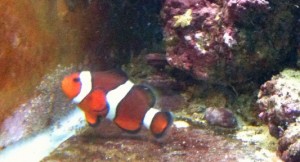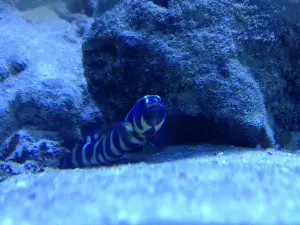Bare bottom reefing

If you are setting up an aquarium in the near future, one of the decisions you will have to make is whether you want to go with a bare bottom. I’m not kidding. Bare bottom reefing is the rage these days—so if you don’t want people to make fun of your DSB, you should take note. Alright, you caught me. I went for the easy puns and sensationalistic language to get your attention. Did it work? Let me take a step back to explain what I’m talking about.
What does it mean to have a bare bottom tank?
It is when you set up your aquarium with no sand or crushed coral along the bottom. As the name implies, you leave the bottom bare (I know, scandalous, right?) In its simplest form, a simple fish-only aquarium (like the one in your local fish store) qualifies as a bare-bottomed tank. But even advanced aquarists may choose to go bare-bottomed with their reef tanks.
What does DSB stand for?
DSB is an abbreviation for Deep Sand Bed. Whereas bare-bottomed tanks have no substrate on the bottom of the aquarium, a tank with a deep sand bed has at least a 4inch (or deeper) layer of sand or crushed coral on the bottom.
So, why the controversy?
Well, let’s face it, if you’re serious about this hobby, you must have free time. And what do people do with the extra time? Spend the money and argue…so…it is a perfect fit.
Deep Sand Bed (DSB)
Pros:
- DSBs harbor beneficial critters like copepods, amphipods, and other invertebrates.
- Even more significantly, DSBs provide a significant amount of substrate to harbor beneficial bacteria that add life-sustaining biological filtration capacity to the tank
- Shallow areas of the DSB provide ‘the useful’ filtration steps of turning ammonia into nitrite and nitrite into nitrate, effectively improving your water parameters
- Deep areas of DSB (areas where oxygen can’t reach) actually harbor bacteria that take nitrates OUT of the water, essentially lowering aquarium nitrates
- DSBs provide a home for burrowing creatures like engineer gobies, jawfish snails and other creatures
Cons:
- DSBs take up valuable real estate in the aquarium that could be filled with more attractive things like coral or live rock
- DSBs can form ‘dead zones’ where noxious chemicals build-up from the de-nitrification process. If too much of the gunk gets ‘churned up, the release of the chemicals into the aquarium could cause problems
Bare Bottomed Tanks
Pros:
- Easier to keep the bottom detritus free and clean
- You can use as much flow as you want without fear of blowing around a lot of sand
Cons:
- Loss of beneficial surface area for biological filtration
- More difficult to keep burrowing species healthy

Conclusion
Like most things in life, there are pros and cons to whichever method you choose. Don’t sit on the sidelines, don’t straddle the fence. Pick a side and join the debate. Bare bottom or DSB… which do you prefer?

Leave a Reply